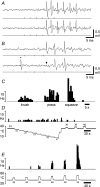Quantitative characterization of low-threshold mechanoreceptor inputs to lamina I spinoparabrachial neurons in the rat
- PMID: 19933757
- PMCID: PMC2821553
- DOI: 10.1113/jphysiol.2009.181511
Quantitative characterization of low-threshold mechanoreceptor inputs to lamina I spinoparabrachial neurons in the rat
Abstract
It has been suggested that primary afferent C-fibres that respond to innocuous tactile stimuli are important in the sensation of pleasurable touch. Although it is known that C-tactile fibres terminate in the substantia gelatinosa (lamina II) of the spinal cord, virtually all of the neurons in this region are interneurons, and currently it is not known how impulses in C-mechanoreceptors are transmitted to higher centres. In the current study, I have tested the quantitative response properties of 'wide dynamic range' projection neurons in lamina I of the spinal cord to graded velocity brushing stimuli to identify whether low-threshold mechanoreceptor input to these neurons arises from myelinated or umyelinated nerve fibres. Graded velocity brushing stimuli (6.6-126 cm s(-1)) were used to characterize the mechanoreceptor inputs to 'wide dynamic range' neurons in lamina I of the dorsal horn that had axons that projected to the contralateral parabrachial nucleus. The most effective tactile stimuli for activation of 'wide dynamic range' lamina I spinoparabrachial neurons were low velocity brush strokes: peak discharge occurred at a mean velocity of 9.2 cm s(-1) (range 6.6-20.4 cm s(-1), s.d. 5.0 cm s(-1)), and declined exponentially as brush velocity increased. The data indicate that C-fibres, but not A-fibres, conveyed low-threshold mechanoreceptor inputs to lamina I projection neurons.
Figures




Comment in
-
Why a soft touch can hurt.J Physiol. 2010 Jan 1;588(Pt 1):13. doi: 10.1113/jphysiol.2009.185116. J Physiol. 2010. PMID: 20045900 Free PMC article. No abstract available.
Similar articles
-
Why a soft touch can hurt.J Physiol. 2010 Jan 1;588(Pt 1):13. doi: 10.1113/jphysiol.2009.185116. J Physiol. 2010. PMID: 20045900 Free PMC article. No abstract available.
-
The sensory neurons of touch.Neuron. 2013 Aug 21;79(4):618-39. doi: 10.1016/j.neuron.2013.07.051. Neuron. 2013. PMID: 23972592 Free PMC article. Review.
-
Sensitization of high mechanothreshold superficial dorsal horn and flexor motor neurones following chemosensitive primary afferent activation.Pain. 1994 Aug;58(2):141-155. doi: 10.1016/0304-3959(94)90195-3. Pain. 1994. PMID: 7816483
-
TRPC1 contributes to light-touch sensation and mechanical responses in low-threshold cutaneous sensory neurons.J Neurophysiol. 2012 Feb;107(3):913-22. doi: 10.1152/jn.00658.2011. Epub 2011 Nov 9. J Neurophysiol. 2012. PMID: 22072513 Free PMC article.
-
PKCγ interneurons, a gateway to pathological pain in the dorsal horn.J Neural Transm (Vienna). 2020 Apr;127(4):527-540. doi: 10.1007/s00702-020-02162-6. Epub 2020 Feb 27. J Neural Transm (Vienna). 2020. PMID: 32108249 Review.
Cited by
-
Long-Lasting Nociplastic Pain Modulation by Repeated Administration of Sigma-1 Receptor Antagonist BD1063 in Fibromyalgia-like Mouse Models.Int J Mol Sci. 2022 Oct 8;23(19):11933. doi: 10.3390/ijms231911933. Int J Mol Sci. 2022. PMID: 36233233 Free PMC article.
-
Physiological properties of the lamina I spinoparabrachial neurons in the mouse.J Physiol. 2019 Apr;597(7):2097-2113. doi: 10.1113/JP277447. Epub 2019 Feb 28. J Physiol. 2019. PMID: 30719699 Free PMC article.
-
Low threshold unmyelinated mechanoafferents can modulate pain.BMC Neurol. 2017 Sep 15;17(1):184. doi: 10.1186/s12883-017-0963-6. BMC Neurol. 2017. PMID: 28915853 Free PMC article. Clinical Trial.
-
Physical contact in parent-infant relationship and its effect on fostering a feeling of safety.iScience. 2021 Jun 12;24(7):102721. doi: 10.1016/j.isci.2021.102721. eCollection 2021 Jul 23. iScience. 2021. PMID: 34235413 Free PMC article. Review.
-
C-low threshold mechanoreceptor activation becomes sufficient to trigger affective pain in spinal cord-injured mice in association with increased respiratory rates.Front Integr Neurosci. 2022 Dec 21;16:1081172. doi: 10.3389/fnint.2022.1081172. eCollection 2022. Front Integr Neurosci. 2022. PMID: 36619238 Free PMC article.
References
-
- Alden M, Besson JM, Bernard JF. Organization of the efferent projections from the pontine parabrachial area to the bed nucleus of the stria terminalis and neighboring regions: a PHA-L study in the rat. J Comp Neurol. 1994;341:289–314. - PubMed
-
- Bernard JF, Alden M, Besson JM. The organization of the efferent projections from the pontine parabrachial area to the amygdaloid complex: a Phaseolus vulgaris leucoagglutinin (PHA-L) study in the rat. J Comp Neurol. 1993;329:201–229. - PubMed
-
- Bessou P, Burgess PR, Perl ER, Taylor CB. Dynamic properties of mechanoreceptors with unmyelinated (C) fibres. J Neurophysiol. 1971;34:116–131. - PubMed
Publication types
MeSH terms
Grants and funding
LinkOut - more resources
Full Text Sources
Other Literature Sources

